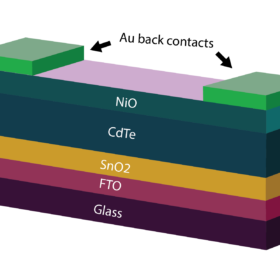Increasing voltage in cadmium telluride solar cells through nickel oxide back buffer layer
Cadmium telluride solar cells are commonly based on non-ohmic back contacts that affect the device open-circuit voltage. Researchers in the United Kingdom sought to address this issue by adding a nickel oxide back buffer layer, which formed an ohmic back contact and increased open-circuit voltage levels.
First Solar opens US research facility
First Solar has commissioned the Jim Nolan Center for Solar Innovation in Lake Township, Ohio. It includes a high-tech pilot manufacturing line to produce full-sized prototypes of thin-film and tandem PV modules.
Semi-transparent PV window based on passive radiative cooling coating
Scientists have manufactured and analyzed a novel coating for semi-transparent photovoltaic glazing that reportedly offers remarkable energy yield and a low heat gain rate. Through outdoor experiments, the researchers also found the glazing also provides satisfactory high-quality indoor lighting conditions.
Perovskite-cadmium telluride tandem solar cell based on special electrode achieves 24.2% efficiency
An Indian-US research team has fabricated a four-terminal perovskite-cadmium telluride tandem solar cell by utilizing a highly conductive and sputtered transparent electrode to increase the current density of the bottom cell. The tandem device combines a 18.3%-efficient top perovskite cell and a 19.53%-efficient cadmium telluride bottom device.
Cadmium telluride solar cell based on indium gallium oxide emitter achieves 17.2%
Developed by the University of Toledo, the cell achived the highest efficiency ever reported for flexible cadmium telluride solar cells to date. The device reached an open-circuit voltage of 861 mV, a short-circuit density of 27.8 mA/cm2, and a fill factor of 71.7%.
Cadmium telluride solar cells show strong resistance after 30,000 orbits around Earth
Researchers in the United Kingdom have tested the perfomance of cadmium telluride solar cells deployed on the AlSat-1N 3U CubeSat satellite from 2016 to 2022. Their findings show the devices exhibited no significant performance changes, nor any sign of delamination.
Novel cadmium telluride solar cell design with potential efficiency of 31.82%
Scientists in Bangladesh designed a cadmium telluride solar cell with upper/top and back contact materials made of aluminum (Al) and nickel (Ni). The device reportedly showed a quantum efficiency of around 100 % at visible wavelengths.
Cadmium selenium telluride solar cell achieves 20% efficiency via bandgap gradient
US scientists have applied bandgap gradient to a cadmium telluride PV cell for the first time. The result is an improvement of its efficiency and open-circuit voltage, and lower non-radiative recombination.
Flexible cadmium telluride solar cell with 12.6% efficiency via lift-off method
A US research team has developed a cadmium telluride (CdTe) solar cell through a lift-off method that reportedly ensures higher crystallinity of the cadmium sulfide film. The device has a power conversion efficiency of 12.60%, an open-circuit voltage of 0.829 V, a short-circuit current density of 23.64 mA/cm2, and a fill factor of 64.30%.
Only5mins! – Thin-film expert on potential of cadmium-telluride solar
Alessandro Romeo, associate professor in experimental physics at Università degli studi di Verona, speaks to pv magazine about the advantages of cadmium-telluride (CdTe) solar cells over other thin-film PV technologies, as well as the commercial implications of future efficiency gains and the prospects for industrial expansion.










